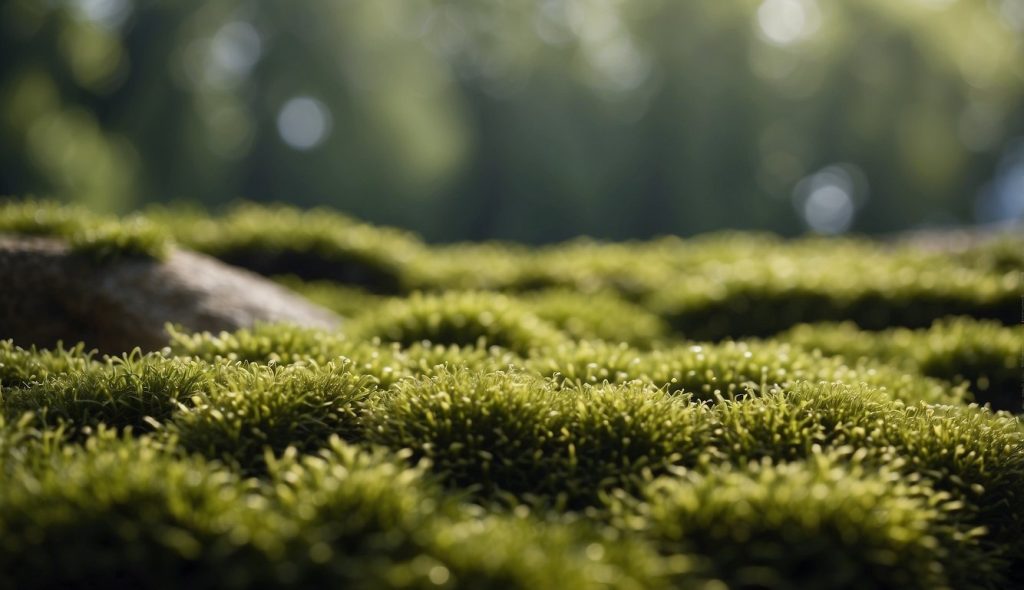How to Apply Purely Organic Lawn Food: Simple Steps for a Greener Yard
Maintaining a lush, green lawn is a goal for many homeowners, and it’s possible to achieve this in an environmentally friendly manner by using purely organic lawn foods.
Organic lawn care involves fostering a healthy ecosystem for your lawn by utilizing natural materials that not only nourish your grass but also support soil health and biodiversity.
I’ve explored the world of purely organic lawn food, and I can share insights on application methods that meet the needs of an eco-conscious gardener, ensuring your lawn thrives without relying on synthetic fertilizers.

In applying purely organic lawn food, it’s crucial to understand what goes into these products and how they benefit your turf and the surrounding environment.
I’ve learned that the best organic lawn care begins with choosing the right product tailored to your specific grass type and soil conditions. These products release nutrients slowly, supporting the lawn’s natural growth cycle.
Once you’ve selected the appropriate organic lawn food, following correct application guidelines helps to prevent overuse and minimizes any potential negative impact on the environment.
Organic lawn foods not only feed your lawn but also improve soil structure and encourage beneficial microbial activity, leading to a robust and sustainable lawn ecosystem.
Key Points…
- Using purely organic lawn food supports a healthy, green lawn and a thriving ecosystem.
- Selecting the correct organic lawn food and following application guidelines can aid in environmentally friendly lawn maintenance.
- Organic lawn care contributes to soil health and reduces the environmental footprint of traditional lawn management practices.
Table of Contents
Understanding Organic Lawn Foods
When I apply organic lawn food, I’m feeding my lawn with natural ingredients that promote healthier soil and a sustainable environment. Let’s explore how using organic fertilizers can be beneficial and how they compare to their chemical counterparts.
Benefits of Organic Fertilizers
Nutrient Release: Organic fertilizers release nutrients gradually, providing a steady supply of food to my grass. Since the nutrients are not immediately soluble, they won’t wash away with the first rain, making them more efficient and long-lasting.
- Soil Structure: These fertilizers improve soil structure. By adding organic matter, I enhance the soil’s ability to retain water and nutrients, which leads to a stronger, more resilient lawn.
- Healthy Soil: A healthy soil is teeming with beneficial microorganisms. Organic fertilizers feed these microorganisms, which in turn support plant growth and help combat disease.
Comparing Organic and Chemical Fertilizers
| Aspect | Organic Fertilizer | Chemical Fertilizer |
|---|---|---|
| Nutrient Release | Slow & steady | Rapid |
| Soil Structure | Improves over time | No significant impact |
| Environmental Impact | Eco-friendly | Potential for runoff |
| Health | Non-toxic | Use with caution |
- Nutrients: Organic fertilizers provide a wide range of nutrients derived from natural sources, versus chemical fertilizers that might offer a quick fix but lack the complexity of organics.
- Natural Ingredients: My organic lawn food is made from things like composted plants, animal manure, or rock powders, which are better for the ecosystem compared to the synthetic compounds found in chemical fertilizers.
Selecting the Right Organic Lawn Food
When I’m looking for organic lawn food, I focus on matching it with my grass type and soil needs and understanding the nutrients in the product.
Assessing Grass Type and Soil Needs
I always start by assessing my lawn’s specific needs. First, I identify the type of grass I have, which is essential since different grass types have varying nutrient requirements.
Then, I conduct a soil test to determine my soil’s pH and existing nutrient levels. This helps me understand what my lawn is lacking and what it doesn’t need.
For example, if my lawn has cool-season grass such as Kentucky bluegrass and the soil test reveals a nitrogen deficiency, I’ll look for a lawn food that’s higher in nitrogen. Conversely, if my soil test shows excess phosphorus, I’ll steer clear of lawn foods high in phosphorus to avoid further imbalance.
Reading Labels: NPK Ratios and Ingredients
Next, I pay close attention to the labels and specifically the NPK rating, which indicates the balance of nitrogen (N), phosphorus (P), and potassium (K).
For instance, an NPK rating of 10-0-2 means the product contains 10% nitrogen, no phosphorus, and 2% potassium. Since nitrogen is key for leaf development, and my soil test showed a need for it, a high nitrogen number like 10 is a good sign.
I also look at the ingredients to ensure they are plant-based and free from synthetic chemicals.
Ingredients like seaweed, fish emulsion, or composted material are common in purely organic lawn foods and are safer for my family and pets. I avoid lawn foods that don’t clearly list their ingredients or seem to include synthetic additives.
Application Guidelines
Applying purely organic lawn food requires attention to timing and the proper use of tools. I’ll guide you through the process, ensuring your lawn benefits from the organic materials effectively and efficiently.
Timing Your Application
Spring: I start applying organic lawn food in the spring when the soil temperature reaches about 55°F. This is usually when grass starts growing, making it the perfect time for the lawn to absorb the nutrients.
Summer: In the summertime, I apply a lighter feeding, preferably in the early part or near the end, to avoid promoting disease during peak heat.
Fall: The fall application is critical for my lawn’s winter survival and spring recovery. I make this application around mid to late fall, which helps to strengthen the roots as the grass prepares for the cold season.
After each application, I ensure to water in the organic lawn food, which helps in the breakdown and soil absorption of the nutrients.
Using Fertilizer Spreaders
For uniform distribution, I use a broadcast or drop spreader. To make sure that I’m applying the correct amount, I always check the spreader settings against the recommended rates on the organic lawn food package. Here’s a step-by-step process I follow:
- I calibrate my spreader
- I fill the spreader on a hard surface to prevent spillage onto the lawn
- I apply the fertilizer in parallel lines to ensure even coverage
- I overlap pass lines slightly to avoid strips of un-fertilized grass
- After use, I clean my spreader thoroughly, so it’s ready for the next application
Using a spreader helps me avoid heavy-handed application which can result in feeding the weeds instead of my grass. With these guidelines in mind, delivering nutrients to my lawn becomes a straightforward process.
Maintaining a Healthy Organic Lawn
In my approach to a lush, organic lawn, I focus on nurturing the grass and soil through natural means. It’s about encouraging a thriving ecosystem that supports grass growth and resilience.
Mowing and Watering Best Practices
Mowing: I make sure to mow my lawn only when needed. It’s crucial not to cut the grass too short as this can stress the plants and make them susceptible to pests and diseases.
I keep my mower blades sharp for a clean cut, which helps prevent disease, and I aim to cut only the top third of the grass blade at a time. This practice encourages deeper root growth, leading to a more drought-resistant lawn.
Watering: When it comes to irrigation, less is often more. Overwatering can lead to shallow root systems and environmental stress.
I water my lawn deeply but infrequently, which encourages the roots to grow deeper in search of moisture.
Early morning watering is best because it reduces evaporation and gives the lawn time to dry out during the day, which helps prevent fungal diseases.
Addressing Pests and Diseases Naturally
Dealing with pests and diseases in a purely organic way means getting ahead of problems before they start.
I promote a balanced ecosystem that includes beneficial insects and birds to control pest populations. If an infestation occurs, I might introduce natural predators or use organic pest control methods that don’t harm the surrounding environment.
A healthy lawn is the best defense against disease. I ensure my grass has the proper nutrients by applying organic lawn food, which is rich in natural elements rather than synthetic chemicals.
If there’s an outbreak of disease, I act promptly, removing and composting affected areas if necessary, and employing organic fungicides only as a last resort.
By maintaining my lawn organically, I not only create a safe space for my family and pets but also contribute positively to the local environment.
Supporting the Lawn’s Ecosystem
By nurturing the lawn’s ecosystem with organic lawn food, I focus on promoting a healthy balance of beneficial microbes and mitigating negative environmental impacts. Organic products contain natural ingredients that support the soil and plants while complying with environmental regulations.
Promoting Beneficial Microbes
I ensure that organic lawn food is rich in composted materials, which provide a source of organic matter. This introduces and feeds various microorganisms beneficial to my lawn’s health. For example, I apply:
- Compost: Introduces a variety of microbes.
- Worm castings: Encourage microbial diversity which aids in nutrient breakdown and absorption.
These organic inputs stimulate microbial activity, which in turn converts nutrients into a form easily assimilated by my grass. It’s like providing a feast for the soil’s tiny workers that keep my lawn lush and healthy.
Avoiding Negative Environmental Impacts
When applying lawn food, I make sure to avoid potential negative impacts on the environment. This means:
- Following Regulations: Strictly adhering to local environmental regulations to ensure I do not damage the ecosystem.
- Reducing Runoff: Applying the right amount of organic lawn food to prevent nutrient runoff, which can harm local waterways.
I also eschew synthetic fertilizers, which are often linked with ecosystem disruption. Opting for organic lawn food, I contribute to a reduced environmental footprint while supporting the intricate web of life beneath my lawn.
Frequently Asked Questions
I’ve compiled a list of FAQs to help you apply organic lawn food effectively and address common concerns you might have.
What are the steps for applying organic lawn food to my garden?
Firstly, I make sure to read the product instructions carefully. I use a spreader to evenly distribute the organic lawn food across my garden, then I rake the lawn lightly to let the food penetrate the soil.
How often is it recommended to use purely organic fertilizer on my lawn?
I generally apply organic fertilizer to my lawn every 6-8 weeks during the growing season. However, the frequency can depend on the specific product’s guidelines and the needs of my lawn.
Is Purely Organic Lawn Food safe for pets, and what precautions should I take?
In my experience, purely organic lawn food is safe for pets. I still keep my pets off the lawn until the product is absorbed or washed in with rain or watering, just to be cautious.
What are some top-rated organic lawn products similar to Purely Organic Lawn Food?
Some organic lawn products that I find to be top-rated include Espoma Organic Lawn Food and Scotts Natural Lawn Food. They’re reputable brands that are known for their effectiveness.
After using Purely Organic Lawn Food, should I water my lawn immediately?
I always check the label, but watering after application is typically recommended to help the organic lawn food settle in. If the forecast calls for rain, I might skip watering and let nature do the work.
Can you guide me on how to effectively use organic lawn fertilizers for the best results?
For the best results, I apply organic fertilizers when my lawn is dry and mow it a few days before. I also ensure soil contact by raking and aerate my lawn periodically to improve nutrient absorption.







